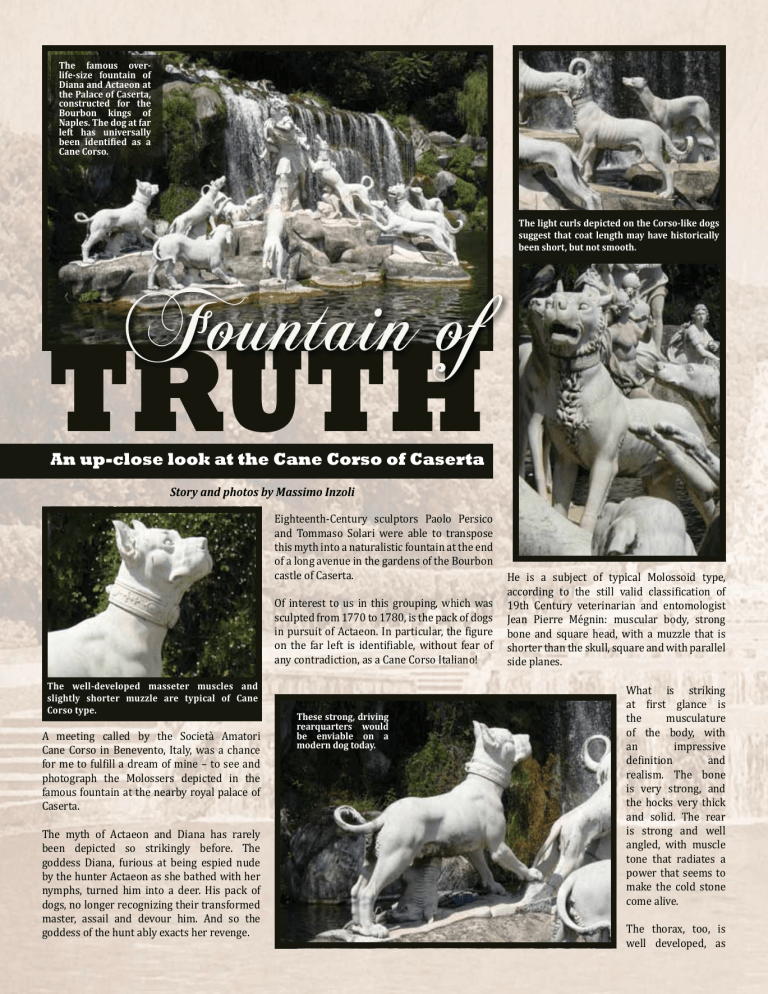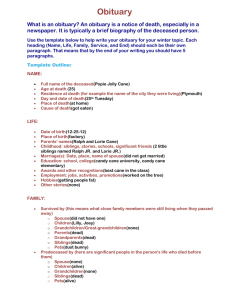An up-close look at the Cane Corso of Caserta

life-size fountain of
Diana and Actaeon at the Palace of Caserta, constructed for the
Naples. The dog at far left has universally been identified as a
Cane Corso.
The light curls depicted on the Corso-like dogs suggest that coat length may have historically been short, but not smooth.
TRUTH
An up-close look at the Cane Corso of Caserta
Story and photos by Massimo Inzoli
Eighteenth-Century sculptors Paolo Persico and Tommaso Solari were able to transpose this myth into a naturalistic fountain at the end of a long avenue in the gardens of the Bourbon castle of Caserta.
Of interest to us in this grouping, which was sculpted from 1770 to 1780, is the pack of dogs in pursuit of Actaeon. In particular, the figure on the far left is identifiable, without fear of any contradiction, as a Cane Corso Italiano!
He is a subject of typical Molossoid type, according to the still valid classification of
19th Century veterinarian and entomologist
Jean Pierre Mégnin: muscular body, strong bone and square head, with a muzzle that is shorter than the skull, square and with parallel side planes.
The well-developed masseter muscles and slightly shorter muzzle are typical of Cane
Corso type.
A meeting called by the Società Amatori
Cane Corso in Benevento, Italy, was a chance for me to fulfill a dream of mine – to see and photograph the Molossers depicted in the famous fountain at the nearby royal palace of
Caserta.
The myth of Actaeon and Diana has rarely been depicted so strikingly before. The goddess Diana, furious at being espied nude by the hunter Actaeon as she bathed with her nymphs, turned him into a deer. His pack of dogs, no longer recognizing their transformed master, assail and devour him. And so the goddess of the hunt ably exacts her revenge.
rearquarters would modern dog today.
What is striking at first glance is the musculature of the body, with an impressive definition and realism. The bone is very strong, and the hocks very thick and solid. The rear is strong and well angled, with muscle tone that radiates a power that seems to make the cold stone come alive.
The thorax, too, is well developed, as
typical collars of the period, called vraccale, which were very thick to protect the delicate exposed throat from being grievously wounded, and were furnished with a strong ring to which a chain or rope could be attached.
muscles. The muzzle is slightly shorter than the skull, with a lip that is rather moderate. I was struck by the inverted U-shape of the lips; the chin is very evident, perhaps forming a bite that would conform to the one dictated by the modern standard.
The ears are cropped in almost all the dogs, even those of greyhound type, which would be A discordant note in the head is a nose with
A rear view, demonstrating the strong and stable hocks.
is the musculature of the shoulders, which manages to communicate the energy and muscular tension of the animal in the moment he focuses on Actaeon.
Almost all the dogs in the sculpture wear the a very practical and common practice of the time. By contrast, the tails are undocked, proof of the real functionality of this appendage, the docking of which I have never found myself in agreement with. Better, in my opinion, is the practice of the mastinari (Neapolitan Mastiff breeders) to crop only one-third of the tail, minimizing any sores or ulcers on the tip, and still maintaining the utility of this functional appendage for the dog.
The definition of the head is striking, and appears well sculpted (you’ll forgive the pun), with the obvious musculature of the masseter a downward direction, which ruins the anterolateral profile of the muzzle.
Finally, the dogs are depicted with light curls at the back of their thighs and some also lightly on the neck. It’s proof that the coat of the Cane
Corso was short, but not smooth.
After an extensive session of photo-taking from many different angles, I went to my meeting in
Benevento – hot, yes, but pleased and satisfied with my dip into this piece of Italian dog-art history.
collar is typical of the period, used for both protection and tethering.
About
The
Author
A breeder of Dogo Argentinos with the affix “de
Angel o Demonio” since 1994, Massimo Inzoli’s life with dogs started as a youngster in the late
1970s, when his family bred a few litters of
Neapolitan Mastiffs and he grew up amid the legs of a few of them. A Dogo Argentino and Cane
Corso specialist judge, he judges all the breeds in FCI Group 2 (which includes the Molossers) and Group 4 (Dachshunds), as well as bull-type terriers, Akita Inus and Alaskan Malamutes. He has judged Cane Corso in many specialty shows in Italy as well as the U.S., Israel, Belorussia,
Hungary, Poland and the Czech Republic and in all-breeds shows throughout Western Europe.









